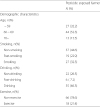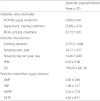1. Gomez C, Bandez MJ, Navarro A. Pesticides and impairment of mitochondrial function in relation with the parkinsonian syndrome. Front Biosci. 2007; 12:1079–1093. DOI:
10.2741/2128. PMID:
17127363.
2. Chandra , Pangtey BS, Modak DP, et al. Biological monitoring of chlorinated pesticides among exposed workers of mango orchards: a case control study in tropical climate. Bull Environ Contam Toxicol. 1992; 48:295–301. DOI:
10.1007/BF00194387. PMID:
1371423.
3. Guillette EA, Maria Mercedes M, Maria Guadalupe A, Alma Delia S, Idalia Enedina G. An Anthropological Approach to the Evaluation of Preschool Children Exposed to pesticides in Mexico. Environ Health Perspect. 1998; 106(6):347–353. DOI:
10.1289/ehp.98106347. PMID:
9618351.
4. Weichenthal S, Moase C, Chan P. A review of pesticide exposure and cancer incidence in the Agricultural Health Study cohort. Environ Health Perspect. 2010; 118(8):1117–1125. DOI:
10.1289/ehp.0901731. PMID:
20444670.
5. Lee WJ, Blair A, Hoppin JA, Lubin JH, Rusiecki JA, et al. Cancer incidence among pesticide applicators exposed to chlorpyrifos in the Agricultrual Health Study. J Natl Cancer Inst. 2004; 96(23):1781–1789. DOI:
10.1093/jnci/djh324. PMID:
15572760.
6. Almedia MG, et al. Pro-and anti-oxidant parameters in rat liver after short-term exposure to hexacholorobenzene. Hum Exp Toxicol. 1997; 16:257–261. DOI:
10.1177/096032719701600504. PMID:
9192204.
7. Banerjee BD, et al. Biochemical effects of pesticides on lipid peroxidation and free radicals scavengers. Toxicol Lett. 1999; 107:33–37. DOI:
10.1016/S0378-4274(99)00029-6. PMID:
10414779.
8. Susan J, et al. Protective effect of vitamin E in dimethoate and malathion induced oxidative stress in rat erythrocytes. J Nutr Biochem. 2001; 12:500–504. DOI:
10.1016/S0955-2863(01)00160-7. PMID:
11834209.
9. Abdollahi M, et al. Oxidative stress and cholinesterase inhibition in saliva and plasma of rats following subchronic exposure to malathion. Comp bio Biochem Physiol Part C. 2004; 137:29–34.
10. Ranjbar A, Pasalar P, Sedighi A, Abdollahi M. Induction of oxidative stress in paraquat formulating workers. Toxicol Lett. 2002; 131:191–194. DOI:
10.1016/S0378-4274(02)00033-4. PMID:
11992738.
11. Lee CH, Kamijima M, Kim H, et al. 8-Hydroxydeoxyguanosine levels in human leukocyte and urine according to exposures to organophosphorus pesticides and paraoxonase 1 genotype. Int Arch Occup Environ Health. 2007; 80:217–227. DOI:
10.1007/s00420-006-0128-1. PMID:
16915393.
12. Basu S. Fatty acid oxidation and isoprostanes: Oxidative strain and oxidative stress. Prostaglandins Leukot Essent Fatty Acids. 2010; 82:219–225. DOI:
10.1016/j.plefa.2010.02.031. PMID:
20363116.
13. Kasai H, et al. Life style and urinary 8-hydroxydeoxyguanosine, a marker of oxidative DNA damage: effects of exercise, working conditions, meat intake, body mass index, and smoking. Jpn J Cancer Res. 2001; 92(1):9–15. DOI:
10.1111/j.1349-7006.2001.tb01041.x. PMID:
11173538.
15. Dosemeci M, Michael CR, et al. A quantitative approach for estimating exposure to pesticide in the agricultural health study. Ann Occup Hyg. 2002; 46(2):245–260. PMID:
12074034.
16. Ueyama J, Saito I, et al. Simultaneous determination of urinary dialkylphosphate metabolites of organophosphorus pesticides using gas chromatography-mass spectrometry. J Chromatogr B. 2006; 832:58–66. DOI:
10.1016/j.jchromb.2005.12.030.
17. Ahmed RS, Vandana S, Pasha ST, Banerjee BD. Influence of dietary ginger(Zingiber officinalis Rosc) on oxidative stress induced by malathion in rats. Food Chem Toxicol. 2000; 38:443–450. DOI:
10.1016/S0278-6915(00)00019-3. PMID:
10762730.
18. Singh VK, Jyoti , Krishna Reddy MM, Kesavachandran C, Rastogi SK, Siddiqui MK. Biomonitoring of organochlorines, glutathione, lipid peroxidation and cholinesterase activity among pesticide sprayers in mango orchards. Clin Chim Acta. 2007; 377:268–272. DOI:
10.1016/j.cca.2006.08.037. PMID:
17067563.
19. Soltaninejad K, Abdollahi M. Current opinion of the science of organophosphate pesticides and toxic stress: A systematic review. Med Sci Monit. 2009; 15:75–90.
20. Lukaszewicz-Hussain A. Role of oxidative stress in organophosphate insecticide toxicity-Short review. Pest Biochem Physiol. 2010; 98:145–150. DOI:
10.1016/j.pestbp.2010.07.006.
21. Kamath V, Rajini PS. Altered glucose homeostasis and oxidative impairment in pancreas of rats subjected to dimethoate intoxication. Toxicology. 2007; 231:137–146. DOI:
10.1016/j.tox.2006.11.072. PMID:
17197067.
22. Rahimi R, Abdollahi M. A review on the mechanisms involved in hyperglycemia induced by organophosphorus pesticides. Pesti Biochem Physiol. 2007; 88:115–121. DOI:
10.1016/j.pestbp.2006.10.003.
23. Oral B, Guney M, Demirin H, et al. Endometrial damage and apoptosis in rats induced by dichlorvos and ameliorating effect of antioxidant vitamin E and C. Reproductive Toxicol. 2006; 22:783–790. DOI:
10.1016/j.reprotox.2006.08.003.
24. Kaur P, Radotra B, Minz RW, Gill KD. Impaired mitochondrial energy metabolism and neuronal apoptotic cell death after chronic dichlorvos (OP) exposure in rat brain. NeuroToxicol. 2007; 28:1208–1219. DOI:
10.1016/j.neuro.2007.08.001.
25. Gultekin F, Delibas N, Yasar S, Kilinc I. In vivo changes in antioxidant systems and protective role of melatonin and a combination of vitamin C and vitamin E on oxidative damage in erythrocytes induced by chlorpyrifosethyl in rats. Arch Toxicol. 2001; 75:88–96. DOI:
10.1007/s002040100219. PMID:
11354911.
26. Prakasam AS, Sethupathy S, Lalitha . Plasma and RBCs antioxidant status in occupational male pesticide sprayers. Clin Chim Acta. 2001; 310:107–112. DOI:
10.1016/S0009-8981(01)00487-9. PMID:
11498075.
27. Loewenherz C, Fenske RA, Simcox NJ, Beltarny G, Kalman D. Biological monitoring of organophosphorus pesticide exposure among children of agricultural workers in central washington state. Environ Health Perspect. 1997; 105:1344–1353. DOI:
10.1289/ehp.971051344. PMID:
9405329.
28. Yu F, Wang Z, Ju B, Wang Y, Wang J, Bai D. Apoptotic effect of organophosphorus insecticide chlorpyrifos on mouse retina in vivo via oxidative stress and protection of combination of vitamins C and E. Exp Toxicol Pathol. 2008; 59(6):415–423. DOI:
10.1016/j.etp.2007.11.007. PMID:
18222074.








 PDF
PDF Citation
Citation Print
Print



 XML Download
XML Download